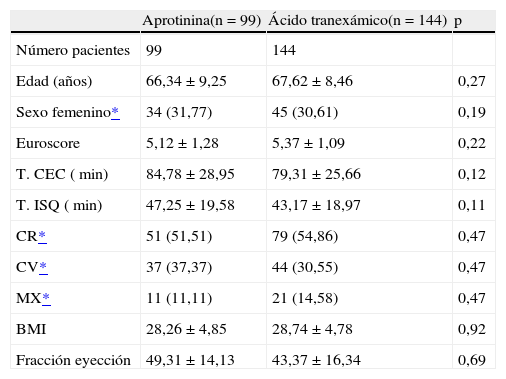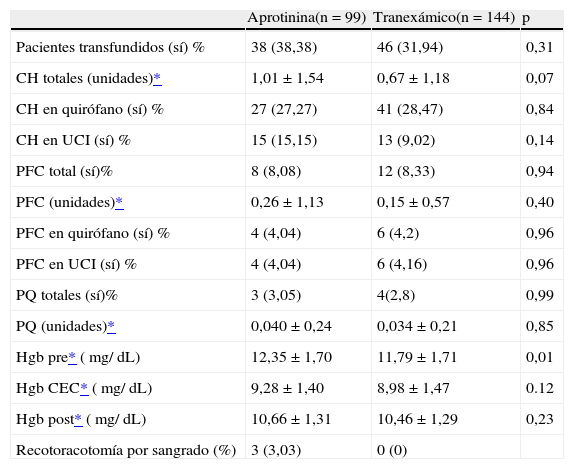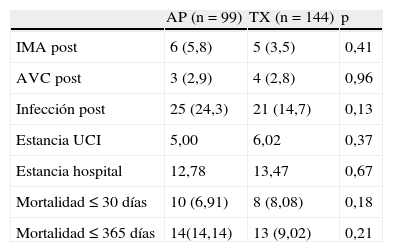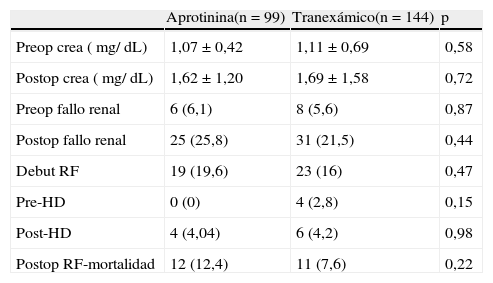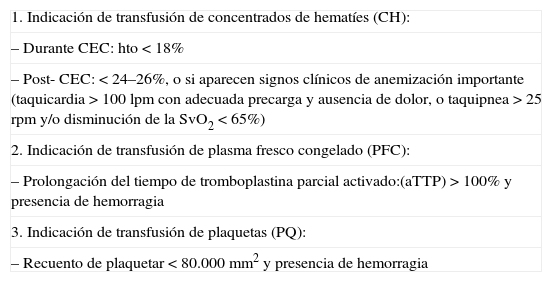Evaluar los requerimientos transfusionales y morbimortalidad en relación con los antifibrinolíticos empleados (aprotinina o ácido tranexámico) en pacientes sometidos a cirugía cardiaca.
Pacientes y métodoEstudio comparativo, retrospectivo, de 243 pacientes sometidos a cirugía cardiaca, en relación al antifibrinolítico empleado, entre diciembre 2006 y junio 2008. Se registraron procedimientos quirúrgicos, necesidades transfusionales de hemoderivados, morbimortalidad –especialmente renal– y estancia hospitalaria.
ResultadosDistribuidos en dos grupos, ácido tranexámico (TX, n=144) y aprotinina (AP, n=99), se objetivó una incidencia de transfusión de sangre alogénica inferior en el grupo TX (31,94% frente a 38,38%; p=0,31), pero sin diferencia estadística. El grupo TX recibió una media de 0,67±1,18 U de concentrado de hematíes totales, frente a 1,01±1,54 U del grupo AP (p=0,07). El valor medio de la hemoglobina preoperatoria del grupo TX resultó inferior (11,79±1,71 mg/dL) respecto al grupo AP (12,35±1,70 mg/dL) de modo significativo (p<0,01). La disfunción renal postoperatoria debutante se presentó en mayor frecuencia en el grupo AP (19,6% frente a 16%, p=0,47). La mortalidad ≤ 1 año fue inferior en el grupo TX (9,02% frente a 14,14%, p=0,21), persistiendo esta diferencia al relacionar la mortalidad con la disfunción renal postoperatoria (7,6% frente a 12,4%, p=0,22). No evidenciamos diferencias significativas en relación a complicaciones postoperatorias, ni estancia hospitalaria. Sin embargo, la ausencia de randomización y la limitada muestra del estudio, restringen las conclusiones definitivas.
ConclusionesEl presente trabajo demuestra con las limitaciones mencionadas, que en nuestro medio, el ácido tranexámico empleado en cirugía cardiaca es tan efectivo como la aprotinina a la hora de disminuir los requerimientos transfusionales
To evaluate transfusion requirements, morbidity and mortality when 2 antifibrinolytic agents (aprotinin and tranexamic acid) were used in patients undergoing cardiac surgery.
Patients and methodsComparison of the effects of 2 antifibrinolytic agents in 243 patients undergoing cardiac surgery between December 2006 and June 2008. We recorded the surgical procedures used, blood product transfusions required, complications (particularly renal), mortality, and length of hospital stay.
ResultsThe patients were distributed into 2 groups to receive tranexamic acid (n=144) or aprotinin (n=99). The incidence of transfusion in the tranexamic acid group (31.94%) was nonsignificantly lower than in the aprotinin group (38.38%) (P=.31). The mean (SD) number of units of packed red blood cells transfused was 0.67 (1.18) in the tranexamic acid group and 1.01 (1.54) in the aprotinin group (P=.07). The mean preoperative hemoglobin concentration in the tranexamic acid group (11.79 [1.71] mg/dL) was significantly lower than in the aprotinin group (12.35 [1.70] mg/dL) (P<.01). Incipient postoperative renal failure tended to occur more frequently in the aprotinin group (19.6% compared to 16%; P=.47). Mortality at 1 year was 9.02% in the tranexamic acid group (compared to 14.14% in the aprotinin group; P=.21); the trend for mortality related to postoperative renal failure was similar (7.6% in the tranexamic acid group compared to 12.4% in the aprotinin group; P=.22). No significant differences were observed in postoperative complications or length of hospital stay. However, the lack of randomization and the small sample size do not allow for definitive conclusions.
ConclusionsThis study, subject to the aforementioned limitations, shows that tranexamic acid is as effective as aprotinin for reducing transfusion requirements in cardiac surgery in Spain
Artículo
Comprando el artículo el PDF del mismo podrá ser descargado
Precio 19,34 €
Comprar ahora









